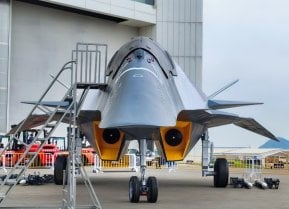China Reveals Its New CH-7 Stealth Drone
The recent unveiling of the CH-7 indicates China is elevating its UAV prowess in order to integrate these assets into a broader military strategy.
The Chinese military introduced a range of new aircraft designs on the first day of its Zhuhai Air Show. From sixth-generation fighter jet renderings to stealth unmanned aerial vehicles (UAVs), Beijing is clearly making massive strides in this arena. The reveal of the CH-7 high-altitude, long-endurance stealth drone designed by the China Aerospace Science and Technology Corporation (CASC) particularly garnered attention from exhibition attendees.
In the published images and video footage released by Chinese state-run media outlets, an impressively large drone is featured. If the People’s Republic of China’s claims regarding this futuristic-looking UAV are accurate, CH-7 could undertake strike missions as an uncrewed combat aerial vehicle when eventually introduced.
What we know about the CH-7 drone
When the CH-7 was first unveiled back in 2018, it looked quite different than the design displayed at the 2024 Zhuhai Air Show. The UAV has undergone some adaptation phases since then in order to feature improvements in stealth and endurance. The drone appears to measure roughly 32 feet in length with a wingspan of approximately 85 feet. Western analysts believe that the stealth UAV has a take-off weight of just over 22,000 pounds and a maximum speed of 575 miles per hour.
These estimates are hard to verify, however, since Beijing has yet to release more detailed specs.
The War Zone has provided a detailed overview of the CH-7 based on released footage. According to the news outlet, the current prototype appears to be larger in size than the initial rendition of the UAV publicized back in 2018: “Notable features when looking at the rear aspect of the drone in its latest version include prominent gaps inboard of the trailing-edge flaps, where the wing meets the blended body section. It is likely a temporary configuration and a gap-filler would fill this section.
A slot-like low-observable platypus engine exhaust, with the nozzle fully concealed from most angles of view is also visible.”
The future of drone warfare
Since Russia first invaded Ukraine back in early 2022, the role drones can play in modern warfare has become more apparent. These cheaper, easy to acquire, and lethal weapons provide their users with the ability to swarm targets, carry out surveillance and reconnaissance missions, and strike when necessary. The recent unveiling of the CH-7 indicates China is elevating its UAV prowess in order to integrate these assets into a broader military strategy.
The United States is similarly banking on the future of drone warfare. The Air Force’s upcoming Next-Generation Air Dominance (NGAD) “family of systems” will incorporate a sixth-generation fighter and 1,000 Collaborative Combat Aircraft (CCAs). These “loyal wingmen” UAVs will provide a whole new slate of capabilities for the service, since they will be uncrewed and therefore able to conduct more risky operations. Beijing is expected to integrate sophisticated UAVs into its own sixth-generation fighter program.
While minimal information surrounding the “White Emperor” has been divulged to the public, this new platform will undoubtedly compete with its American counterpart when introduced.
About the Author: Maya Carlin, Defense Expert
Maya Carlin, National Security Writer with The National Interest, is an analyst with the Center for Security Policy and a former Anna Sobol Levy Fellow at IDC Herzliya in Israel. She has by-lines in many publications, including The National Interest, Jerusalem Post, and Times of Israel. You can follow her on Twitter: @MayaCarlin. Carlin has over 1,000 articles published over the last several years on various defense issues.
Image Credit: Creative Commons and/or Shutterstock


